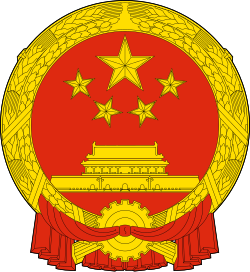Emblem of the People's Republic of China
| National Emblem of the People's Republic of China | |
|---|---|
 |
|
| Details | |
| Armiger | People's Republic of China |
| Adopted | 20 September 1950 |
| Escutcheon | Red disc with a representation below of the Tiananmen, the entrance gate of the Forbidden City as seen from the Tiananmen Square in Beijing and five stars above. The outer border is composed of sheaves of wheat and the inner border of sheaves of rice, with a cog-wheel at the center of the bottom portion of the border. |
| National Emblem of the People's Republic of China | |||||||
| Traditional Chinese | 中華人民共和國國徽 | ||||||
|---|---|---|---|---|---|---|---|
| Simplified Chinese | 中华人民共和国国徽 | ||||||
|
|||||||
| Transcriptions | |
|---|---|
| Standard Mandarin | |
| Hanyu Pinyin | Zhōnghuá Rénmín Gònghéguó guóhuī |
The National Emblem of the People's Republic of China contains in a red circle a representation of Tiananmen Gate, the entrance gate to the Forbidden City, where Mao declared the foundation of the People's Republic of China (PRC) in 1949. Above this representation are the five stars found on the national flag. The largest star represents the Communist Party of China, while the four smaller stars represent the four social classes as defined in Maoism. The emblem is described as being "composed of patterns of the national flag":
...The red color of the flag symbolizes revolution and the yellow color of the stars the golden brilliant rays radiating from the vast red land. The design of four smaller stars surrounding a bigger one signifies the unity of the Chinese people under the leadership of the Communist Party of China (CPC)
—China Yearbook 2004
The outer border of the red circle shows sheaves of wheat and the inner sheaves of rice, which together represent agricultural workers. At the center of the bottom portion of the border is a cog-wheel that represents industrial workers.
According to The Description of the National Emblem of the People's Republic of China (中華人民共和國國徽圖案說明), these elements taken together symbolise the revolutionary struggles of the Chinese people since the May Fourth Movement and the coalition of the proletariat which succeeded in founding the People's Republic of China.
On July 10, 1949 the government held a public competition for the design of the national emblem, however no satisfactory designs were selected. Therefore, on September 27, 1949, the First Plenary Session of CPPCC decided to invite designers for the proposals of the national emblem and two groups from two universities were selected in September 1949. Three proposals were selected for the first round discussion:
Proposals of China Central Academy of Fine Arts, September 25, 1949
Proposal of Tsinghua University, October 30, 1949
...
Wikipedia
